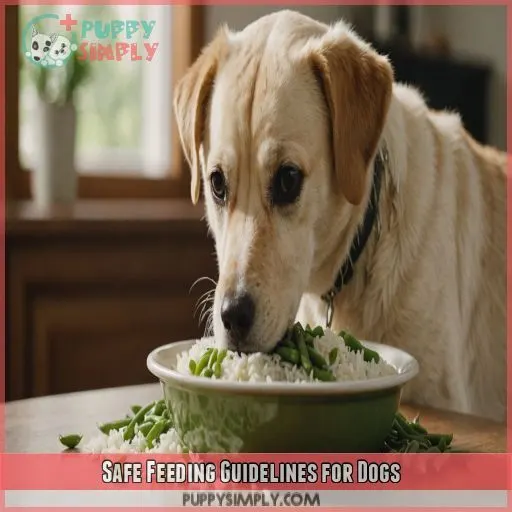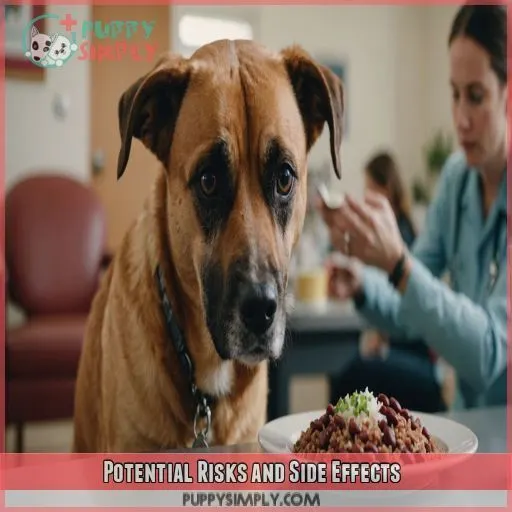This site is supported by our readers. We may earn a commission, at no cost to you, if you purchase through links.

Red beans are a great source of protein, fiber, and vitamins for dogs, while rice provides sustained energy.
However, it’s essential to cook them properly to reduce phytohemagglutinin, a natural toxin in red beans.
Introduce them gradually to prevent digestive upset, and consider your dog’s individual needs and health conditions.
Can dogs eat red beans and rice? Absolutely, but with some careful planning and attention to detail – more on that in a bit!
Table Of Contents
Key Takeaways
- To reduce phytohemagglutinin, a natural toxin that can cause stomach upset in dogs, cook red beans to perfection. Boil or steam them until they’re tender, and follow safe cooking ratios to avoid undercooking or overcooking.
- When introducing red beans and rice to your dog’s diet, do it gradually to prevent digestive upset. Start with a small amount, mixing a teaspoon of the new food with their regular dog food, and monitor for reactions. Space out the frequency and timing to catch any signs of intolerance, and adjust accordingly.
- Portion sizes are important when sharing red beans and rice with your dog. A general rule of thumb is to start with 1/4 to 1/2 cup of cooked red beans and rice per 10 pounds of body weight, adjusting according to your dog’s size, breed, age, and activity level. Consult with your vet for personalized feeding recommendations.
- Balance red beans and rice with your dog’s regular diet to ensure they get all the necessary nutrients. Combine cooked red beans and rice with their commercial dog food or create a balanced homemade diet, but always prioritize their health and well-being, unlike unhealthy snack options.
, but always prioritize their health and well-being. If you’re unsure, consult with your vet or a pet nutritionist.
Nutritional Benefits for Dogs
You’re probably wondering if red beans and rice are a nutritious and safe addition to your furry friend’s diet – and the answer might surprise you! Red beans and rice offer a powerhouse of protein, fiber, vitamins, and minerals that can provide several health benefits for your dog, Red beans and rice offer a powerhouse of protein, fiber, vitamins, and minerals that can provide several health benefits for your dog, from supporting canine digestive health to boosting their energy levels.
.
Protein Content of Red Beans
Red beans are a good source of protein for dogs.
One cup of cooked red beans contains about 15 grams of protein.
Red bean protein is lower in fat and higher in fiber than meat protein.
As a dog owner, you should consider your furry friend’s protein needs.
Red beans can be a nutritious addition to your dog’s diet.
Fiber and Digestive Health
For fiber and digestive health, red beans are a powerhouse for your pup! The fiber in red beans can help regulate stool consistency, preventing diarrhea or constipation. Plus, it can even support the growth of beneficial gut bacteria. Paired with easily digestible rice, red beans can be a gentle, nutritious addition to your dog’s diet.
Vitamins and Minerals in Red Beans
As you explore the realm of red beans for your furry friend, you’ll be thrilled to know they’re packed with vitamins and minerals! Red beans are a rich source of iron, vitamin B, and other minerals that support healthy growth and development in dogs. These bean benefits can boost your pup’s energy levels and overall well-being.
Benefits of Rice for Canine Diet
So, how does rice fit into your dog’s diet? Rice is a nutrient-rich food that provides sustained energy for your furry friend. Here are some benefits of rice for canine diets:
- Rich in carbohydrates for sustained energy
- Easy to digest, reducing stomach upset
- Brown rice is high in fiber, promoting digestive health
- Supports healthy gut bacteria and immune system function
Safe Feeding Guidelines for Dogs
Now that you know the nutritional benefits of red beans and rice for your furry friend, it’s time to learn how to safely feed them to your dog.
In this section, you’ll discover the best cooking and preparation methods for red beans and rice.
You’ll also learn how to introduce red beans and rice into your dog’s diet.
Additionally, you’ll find out the ideal portion sizes to avoid overfeeding and weight gain.
Cooking and Preparation Methods
Now that you know the nutritional benefits of Omega-3 Rich Foods for your dog, let’s get cooking
, let’s get cooking! To make them safe and digestible, use these cooking methods:
| Cooking Method | Red Beans | Rice |
|---|---|---|
| Boiling | 1:4 water ratio | 2:1 water ratio |
| Steaming | 30-40 minutes | 15-20 minutes |
| Pressure Cooking | 20-30 minutes | 5-10 minutes |
Boiling and steaming can help reduce phytohemagglutinin, a natural toxin in red beans. Always follow safe cooking ratios to avoid undercooking or overcooking.
Introducing Red Beans and Rice Gradually
Now that you’ve mastered cooking and preparing red beans and rice for your furry friend, it’s time to introduce it into their diet gradually. Start small, Start small, mixing a teaspoon of the new food with their regular dog food, and monitor for reactions like Pesto Toxicity Symptoms.
, and monitor for reactions. Space out the frequency and timing to catch any signs of intolerance, and adjust accordingly.
Recommended Portion Sizes
If you’re planning to share red beans and rice with your furry friend, portion sizes matter. A general rule of thumb is to start with 1/4 to 1/2 cup of cooked red beans and rice per 10 pounds of body weight, adjusted according to your dog’s size, breed, age, and activity level. Consult with your vet for personalized feeding recommendations.
Avoiding Overfeeding and Weight Gain
You’re excited to share those tasty red beans and rice with your furry friend, but don’t overdo it! Practice portion control and calorie counting to prevent weight gain. Limit treats to 10% of their daily calories and balance with a healthy exercise routine. Monitor their weight and adjust as needed. A happy pup is a healthy pup!
Potential Risks and Side Effects
As you consider adding red beans and rice to your dog’s diet, you should be aware of the potential risks and side effects that may arise. From gastrointestinal issues to allergic reactions, understanding these risks will help you make informed decisions and keep your furry friend safe and healthy.
Gastrointestinal Issues in Dogs
- Dog diarrhea or loose stools
- Vomiting after meals
- Food sensitivities or intolerances
- IBS (Irritable Bowel Syndrome)
- Gastrointestinal parasites, like worms or protozoa, which can exacerbate digestive issues.
Allergic Reactions to Red Beans or Rice
Now that we’ve tackled gastrointestinal issues, let’s talk about allergic reactions to red beans or rice. If your dog is allergic, you’ll notice symptoms like itching, hives, or difficulty breathing. Check out this handy table to recognize common signs:
| Symptom | Red Bean Allergy | Rice Sensitivity |
|---|---|---|
| Itching | ||
| Hives | ||
| Vomiting | ||
| Diarrhea | ||
| Lethargy |
Interaction With Other Foods or Medications
When introducing red beans and rice to your dog’s diet, you’ll want to think about potential interactions with other foods or medications. Here are a few things to keep in mind:
- Bean allergies: If your dog has a known bean allergy, it’s best to avoid red beans altogether.
- Rice cautions: Dogs with diabetes or weight issues may need to limit their rice intake.
- Medication interactions: Certain medications, like blood thinners, may interact with the high fiber content in red beans.
- Dog food compatibility: If your dog is on a specific diet, consult with your vet before adding red beans and rice to their meals.
Signs of Food Poisoning in Dogs
Prospect Prospect Prospect Prospect Prospect Prospect Prospect Prospect Prospect Prospect Prospect Prospect Prospect Prospect Prospect Prospect Prospect Prospect Prospect Prospect Prospect Prospect Prospect Prospect Prospect Prospect Prospect Prospect Prospect Prospect Prospect Prospect Prospect Prospect Prospect Prospect Prospect Prospect Prospect Prospect Prospect Prospect Prospect Prospect Prospect Prospect Prospect Prospect Prospect Prospect Prospect Prospect Prospect Prospect Prospect Prospect Prospect Prospect Prospect Prospect Prospect Prospect Prospect Prospect Prospect Prospect Prospect Prospect Prospect Prospect Prospect Prospect Prospect Prospect Prospect Prospect Prospect Prospect Prospect Prospect Prospect Prospect Prospect Prospect Prospect Prospect Prospect Prospect Prospect Prospect Prospect Prospect Prospect Prospect Prospect Prospect Prospect Prospect Prospect Prospect Prospect Prospect Prospect Prospect Prospect Prospect Prospect Prospect Prospect Prospect Prospect Prospect Prospect Prospect Prospect Prospect Prospect Prospect Prospect Prospect Prospect Prospect Prospect Prospect Prospect Prospect Prospect Prospect Prospect Prospect Prospect Prospect Prospect Prospect Prospect Prospect Prospect Prospect Prospect Prospect Prospect Prospect Prospect Prospect Prospect Prospect Prospect Prospect Prospect Prospect Prospect Prospect Prospect Prospect Prospect Prospect Prospect Prospect Prospect Prospect Prospect Prospect Prospect Prospect Prospect Prospect Prospect Prospect Prospect Prospect Prospect Prospect Prospect Prospect Prospect Prospect Prospect Prospect Prospect Prospect Prospect Prospect Prospect Prospect Prospect Prospect Prospect Prospect Prospect Prospect Prospect Prospect Prospect Prospect Prospect Prospect Prospect Prospect Prospect Prospect Prospect Prospect Prospect Prospect Prospect Prospect Prospect Prospect Prospect Prospect Prospect Prospect Prospect Prospect Prospect Prospect Prospect Prospect Prospect Prospect Prospect Prospect Prospect Prospect Prospect Prospect Prospect Prospect Prospect Prospect Prospect Prospect Prospect Prospect Prospect Prospect Prospect Prospect Prospect Prospect Prospect Prospect Prospect Prospect Prospect Prospect Prospect Prospect Prospect Prospect Prospect Prospect Prospect Prospect Prospect Prospect Prospect Prospect Prospect Prospect Prospect Prospect Prospect Prospect Prospect Prospect Prospect Prospect Prospect Prospect Prospect Prospect Prospect Prospect Prospect Prospect Prospect Prospect Prospect Prospect Prospect Prospect Prospect Prospect Prospect Prospect Prospect Prospect Prospect Prospect Prospect Prospect Prospect Prospect Prospect Prospect Prospect Prospect Prospect Prospect Prospect Prospect Prospect Prospect Prospect Prospect Prospect Prospect Prospect Prospect Prospect Prospect Prospect Prospect Prospect Prospect Prospect Prospect Prospect Prospect Prospect Prospect Prospect Prospect Prospect Prospect Prospect Prospect Prospect Prospect Prospect Prospect Prospect Prospect Prospect Prospect Prospect Prospect Prospect Prospect Prospect Prospect Prospect Prospect Prospect Prospect Prospect Prospect Prospect Prospect Prospect Prospect Prospect Prospect Prospect Prospect Prospect Prospect Prospect Prospect Prospect Prospect Prospect Prospect Prospect Prospect Prospect Prospect Prospect Prospect Prospect Prospect Prospect Prospect Prospect Prospect Prospect Prospect Prospect Prospect Prospect Prospect Prospect Prospect Prospect Prospect Prospect Prospect Prospect Prospect Prospect Prospect Prospect Prospect Prospect Prospect Prospect Prospect Prospect Prospect Prospect Prospect Prospect Prospect Prospect Prospect Prospect Prospect Prospect Prospect Prospect Prospect Prospect Prospect Prospect Prospect Prospect Prospect Prospect Prospect Prospect Prospect Prospect Prospect Prospect Prospect Prospect Prospect Prospect Prospect Prospect Prospect Prospect Prospect Prospect Prospect Prospect Prospect Prospect Prospect Prospect Prospect Prospect Prospect Prospect Prospect Prospect Prospect Prospect Prospect Prospect Prospect Prospect Prospect Prospect Prospect Prospect Prospect Prospect Prospect Prospect Prospect Prospect Prospect Prospect Prospect Prospect Prospect Prospect Prospect Prospect Prospect Prospect Prospect Prospect Prospect Prospect Prospect Prospect Prospect Prospect Prospect Prospect Prospect Prospect Prospect Prospect Prospect Prospect Prospect Prospect Prospect Prospect Prospect Prospect Prospect Prospect Prospect Prospect Prospect Prospect Prospect Prospect Prospect Prospect Prospect Prospect Prospect Prospect Prospect Prospect Prospect Prospect Prospect Prospect Prospect Prospect Prospect Prospect Prospect Prospect Prospect Prospect Prospect Prospect Prospect Prospect Prospect Prospect Prospect Prospect Prospect Prospect Prospect Prospect Prospect Prospect Prospect Prospect Prospect Prospect Prospect Prospect Prospect Prospect Prospect Prospect Prospect Prospect Prospect Prospect Prospect Prospect Prospect Prospect Prospect Prospect Prospect Prospect Prospect Prospect Prospect Prospect Prospect Prospect Prospect Prospect Prospect Prospect Prospect Prospect Prospect Prospect Prospect Prospect Prospect Prospect Prospect Prospect Prospect Prospect Prospect Prospect Prospect Prospect Prospect Prospect Prospect Prospect Prospect Prospect Prospect Prospect Prospect Prospect Prospect Prospect Prospect Prospect Prospect Prospect Prospect Prospect Prospect Prospect Prospect Prospect Prospect Prospect Prospect Prospect Prospect Prospect Prospect Prospect Prospect Prospect Prospect Prospect Prospect Prospect Prospect Prospect Prospect Prospect Prospect Prospect Prospect Prospect Prospect Prospect Prospect Prospect Prospect Prospect Prospect Prospect Prospect Prospect Prospect Prospect Prospect Prospect Prospect Prospect Prospect Prospect Prospect Prospect Prospect Prospect Prospect Prospect Prospect Prospect Prospect Prospect Prospect Prospect Prospect Prospect Prospect Prospect Prospect Prospect Prospect Prospect Prospect Prospect Prospect Prospect Prospect Prospect Prospect Prospect Prospect Prospect Prospect Prospect Prospect Prospect Prospect Prospect Prospect Prospect Prospect Prospect Prospect Prospect Prospect Prospect Prospect Prospect Prospect Prospect Prospect Prospect Prospect Prospect Prospect Prospect Prospect Prospect Prospect Prospect Prospect Prospect Prospect Prospect Prospect Prospect Prospect Prospect Prospect Prospect Prospect Prospect Prospect Prospect Prospect Prospect Prospect Prospect Prospect Prospect Prospect Prospect Prospect Prospect Prospect Prospect Prospect Prospect Prospect Prospect Prospect Prospect Prospect Prospect Prospect Prospect Prospect Prospect Prospect Prospect Prospect Prospect Prospect Prospect Prospect Prospect Prospect Prospect Prospect Prospect Prospect Prospect Prospect Prospect Prospect Prospect Prospect Prospect Prospect Prospect Prospect Prospect Prospect Prospect Prospect Prospect Prospect Prospect Prospect Prospect Prospect Prospect Prospect Prospect Prospect Prospect Prospect Prospect Prospect Prospect Prospect Prospect Prospect Prospect Prospect Prospect Prospect Prospect Prospect Prospect Prospect Prospect Prospect Prospect Prospect Prospect Prospect Prospect Prospect Prospect Prospect Prospect Prospect Prospect Prospect Prospect Prospect Prospect Prospect Prospect Prospect Prospect Prospect Prospect Prospect Prospect Prospect Prospect Prospect Prospect Prospect Prospect Prospect Prospect Prospect Prospect Prospect Prospect Prospect Prospect Prospect Prospect Prospect Prospect Prospect Prospect Prospect Prospect Prospect Prospect Prospect Prospect Prospect Prospect Prospect Prospect Prospect Prospect Prospect Prospect Prospect Prospect Prospect Prospect Prospect Prospect Prospect Prospect Prospect Prospect Prospect Prospect Prospect Prospect Prospect Prospect Prospect Prospect Prospect Prospect Prospect Prospect Prospect Prospect Prospect Prospect Prospect Prospect Prospect Prospect Prospect Prospect Prospect Prospect Prospect Prospect Prospect Prospect Prospect Prospect Prospect Prospect Prospect Prospect Prospect Prospect Prospect Prospect Prospect Prospect Prospect Prospect Prospect Prospect Prospect Prospect Prospect Prospect Prospect Prospect Prospect Prospect Prospect Prospect Prospect Prospect Prospect Prospect Prospect Prospect Prospect Prospect Prospect Prospect Prospect Prospect Prospect Prospect Prospect Prospect Prospect Prospect Prospect Prospect Prospect Prospect Prospect Prospect Prospect Prospect Prospect Prospect Prospect Prospect Prospect Prospect Prospect Prospect Prospect Prospect Prospect Prospect Prospect Prospect Prospect Prospect Prospect Prospect Prospect Prospect Prospect Prospect Prospect Prospect Prospect Prospect Prospect Prospect Prospect Prospect Prospect Prospect Prospect Prospect Prospect Prospect Prospect Prospect Prospect Prospect Prospect Prospect Prospect Prospect Prospect Prospect Prospect Prospect Prospect Prospect Prospect Prospect Prospect Prospect Prospect Prospect Prospect Prospect Prospect Prospect Prospect Prospect Prospect Prospect Prospect Prospect Prospect Prospect Prospect Prospect Prospect Prospect Prospect Prospect Prospect Prospect Prospect Prospect Prospect
Health Conditions and Special Considerations
If your furry friend has a pre-existing health condition, you’re probably wondering if red beans and rice are a good idea. Let’s explore how dogs with food allergies or sensitivities, kidney or liver disease, and other special considerations can safely enjoy this tasty duo.
Dogs With Food Allergies or Sensitivities
If your furry friend has food allergies or sensitivities, introducing red beans and rice requires caution. Consider food trial options, like elimination diets, to identify potential allergens. Watch for sensitivity signs, such as itching or digestive issues. Allergy testing methods can also help pinpoint common allergenic ingredients. Develop a dietary restriction plan to guarantee your pup’s comfort and safety.
Dogs With Kidney or Liver Disease
If your furry friend has kidney or liver disease, it’s really important to consult with your vet before serving red beans and rice. A customized kidney diet or liver support plan may be necessary, including protein restrictions. Your vet can help you create homemade recipes that cater to your dog’s specific needs, ensuring their safety and well-being, especially when it comes to avoiding high fat dog treats.
, ensuring their safety and well-being.
Pregnant or Nursing Dogs
If you’re a pet parent expecting a litter, you’re likely wondering about your pregnant or nursing dog’s diet. Red beans and rice can be a nutritious addition, but it’s important to think about their specific needs. Here are three key things to keep in mind:
- Red beans and rice for milk production: These foods can support lactation, but consult with your vet for the right balance.
- Nutritional needs during pregnancy: Pregnant dogs require more calories and protein, which red beans and rice can provide.
- Energy levels: Nursing dogs need plenty of energy, which red beans and rice can help sustain, but monitor their weight to avoid overfeeding.
Puppies and Red Beans and Rice
You know how puppies are always getting into everything? Well, when it comes to red beans and rice, it’s important to be careful. Their little tummies are still getting used to things, and giving them new foods too fast can cause trouble. Here’s a rundown of what to keep in mind:
| Puppy Stage | Red Beans and Rice Guidelines |
|---|---|
| 1-3 months | Avoid entirely, focus on puppy food |
| 4-6 months | Gradually introduce small amounts |
| 7-9 months | Limit to 1/4 cup cooked per 10 pounds |
| 10+ months | Can be used as training treats, in moderation |
Balancing Red Beans and Rice With Canine Diet
Now that you know the nutritional benefits and potential risks of feeding your dog red beans and rice, it’s time to think about how to balance this food combo with their overall canine diet.
You can make sure your furry friend gets all the nutrients they need to thrive by combining red beans and rice with their regular commercial dog food or creating a balanced homemade diet.
Combining With Commercial Dog Food
The mix-and-match game! When combining red beans and rice with commercial dog food, remember portion control is key. Aim for a balanced diet that meets your dog’s nutritional needs. Start by replacing 10-20% of their commercial food with cooked red beans and rice, and adjust as needed. This will help prevent overfeeding and make sure a harmonious blend.
Creating a Balanced Homemade Diet
Now that you’ve considered combining red beans and rice with commercial dog food, let’s explore creating a balanced homemade diet. Think of it as cooking for your furry friend! Consult with a pet nutritionist to craft DIY recipes that meet your dog’s needs. You may need to add nutritional supplements to make sure a well-rounded diet.
Ensuring Complete Nutrition
When creating a balanced homemade diet for your dog, it’s important to make sure they get all the nutrients they need.
Consult with your veterinarian to determine the best mix of red beans, rice, and other ingredients.
Consider adding nutritional supplements or using dog food brands as a reference.
Aim for balanced meals that meet your dog’s specific needs, and always prioritize their health and well-being.
Avoiding Nutritional Deficiencies
Now that you’re creating a balanced homemade diet, Now that you’re creating a balanced homemade diet, it’s time to think about avoiding nutritional deficiencies in dogs
. You want to guarantee your furry friend is getting all the necessary nutrients. Here are some key things to watch out for:
- Mineral balance: Don’t overdo it on the phosphorus or skimp on calcium.
- Vitamin supplements: Consider adding them to fill any gaps.
- Nutrient ratios: Make sure you’re meeting your dog’s specific needs.
- Deficiency symptoms: Keep an eye out for signs of canine malnutrition, like dull coat or lethargy.
Frequently Asked Questions (FAQs)
Can dogs develop allergies to red beans and rice?
Don’t cry over spilt beans! While rare, your dog can develop an allergy to red beans and rice. Monitor for signs like itching, ear infections, or digestive issues, and consult your vet if you suspect a problem.
Are canned red beans safe for canine consumption?
Regarding canned red beans, you should exercise caution – they’re often high in sodium and may contain added preservatives, which can be toxic to your furry friend (Source).
How do red beans compare to other legumes nutritionally?
You’re curious about red beans’ nutritional value compared to other legumes. Red beans are relatively high in fiber, protein, and folate, similar to navy beans and chickpeas , but lower in calories than soybeans .
Can red beans cause stomach upset in sensitive dogs?
If your dog has a sensitive stomach, red beans might cause stomach upset, so monitor their reaction and start with small amounts. Cooked red beans are generally safer than raw ones (Source).
Are red beans suitable for puppies and senior dogs?
Pondering puppies and senior pooches? While red beans can be a nutritious treat, they may not be suitable for young or aging dogs due to potential digestive issues, so consult your vet for personalized advice.
Conclusion
You’ve hit the jackpot – red beans and rice can be a canine culinary dream come true!
With careful planning, your furry friend can reap the nutritional benefits of this dynamic duo.
Remember to cook those beans to perfection, introduce them gradually, and balance with their regular diet.
So, can dogs eat red beans and rice? Absolutely!











